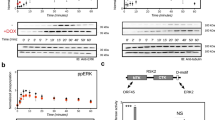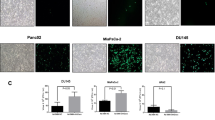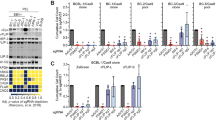Abstract
Kaposi sarcoma-associated herpesvirus (KSHV) is a member of the gammaherpesvirus family. It is the etiological agent of three different human cancers, Kaposi sarcoma (KS), primary effusion lymphoma (PEL) and multicentric Castleman disease. The far left end of the KSHV genome encodes a unique transmembrane glycoprotein called K1. K1 possesses the ability to transform rodent fibroblasts and block apoptosis. K1 has also been shown to activate the PI3K/Akt/mTOR pathway in different cells. Using tandem affinity purification, we identified heat shock protein 90β (Hsp90β) and endoplasmic reticulum-associated Hsp40 (Erdj3/DnaJB11), as cellular binding partners of K1. Interactions of K1 with Hsp90β and Hsp40 were confirmed by co-immunoprecipitation in both directions. Furthermore, K1 also interacted with the Hsp90α isoform. We report that small-interfering RNAs directed against Hsp90 and Hsp40/Erdj3, as well as pharmacological inhibitors of Hsp90, dramatically reduced K1 expression, suggesting that K1 is a client protein of these chaperones. In addition, both Hsp90 and Hsp40/Erdj3 were essential for K1's anti-apoptotic function. Finally, we report that the Hsp90 inhibitors, 17-AAG and 17-DMAG, can suppress the proliferation of KSHV-positive PEL cell lines and exhibited IC50 values of 50 nM and below.
This is a preview of subscription content, access via your institution
Access options
Subscribe to this journal
Receive 50 print issues and online access
$259.00 per year
only $5.18 per issue
Buy this article
- Purchase on Springer Link
- Instant access to full article PDF
Prices may be subject to local taxes which are calculated during checkout









Similar content being viewed by others
References
Berkova Z, Wang S, Wise JF, Maeng H, Ji Y, Samaniego F . (2009). Mechanism of Fas signaling regulation by human herpesvirus 8 K1 oncoprotein. J Natl Cancer Inst 101: 399–411.
Bowser BS, DeWire SM, Damania B . (2002). Transcriptional regulation of the K1 gene product of Kaposi's sarcoma-associated herpesvirus. J Virol 76: 12574–12583.
Burch AD, Weller SK . (2005). Herpes simplex virus type 1 DNA polymerase requires the mammalian chaperone hsp90 for proper localization to the nucleus. J Virol 79: 10740–10749.
Cesarman E, Chang Y, Moore PS, Said JW, Knowles DM . (1995). Kaposi's sarcoma-associated herpesvirus-like DNA sequences in AIDS-related body-cavity-based lymphomas. N Engl J Med 332: 1186–1191.
Chandriani S, Ganem D . (2010). Array-based transcript profiling and limiting-dilution RT-PCR analysis identify additional latent genes in KSHV. J Virol Mar (e-pub ahead of print).
Chang Y, Cesarman E, Pessin MS, Lee F, Culpepper J, Knowles DM et al. (1994). Identification of herpesvirus-like DNA sequences in AIDS-associated Kaposi's sarcoma. Science 266: 1865–1869.
Damania B, DeMaria M, Jung JU, Desrosiers RC . (2000). Activation of lymphocyte signaling by the R1 protein of rhesus monkey rhadinovirus. J Virol 74: 2721–2730.
Damania B, Li M, Choi JK, Alexander L, Jung JU, Desrosiers RC . (1999). Identification of the R1 oncogene and its protein product from the rhadinovirus of rhesus monkeys. J Virol 73: 5123–5131.
Eustace BK, Sakurai T, Stewart JK, Yimlamai D, Unger C, Zehetmeier C et al. (2004). Functional proteomic screens reveal an essential extracellular role for hsp90 alpha in cancer cell invasiveness. Nat Cell Biol 6: 507–514.
Field N, Low W, Daniels M, Howell S, Daviet L, Boshoff C et al. (2003). KSHV vFLIP binds to IKK-gamma to activate IKK. J Cell Sci 116: 3721–3728.
Fujita N, Sato S, Ishida A, Tsuruo T . (2002). Involvement of Hsp90 in signaling and stability of 3-phosphoinositide-dependent kinase-1. J Biol Chem 277: 10346–10353.
Gao T, Newton AC . (2002). The turn motif is a phosphorylation switch that regulates the binding of Hsp70 to protein kinase C. J Biol Chem 277: 31585–31592.
Gessain A, Sudaka A, Briere J, Fouchard N, Nicola MA, Rio B et al. (1996). Kaposi sarcoma-associated herpes-like virus (human herpesvirus type 8) DNA sequences in multicentric Castleman's disease: is there any relevant association in non-human immunodeficiency virus-infected patients? Blood 87: 414–416.
Goetz MP, Toft D, Reid J, Ames M, Stensgard B, Safgren S et al. (2005). Phase I trial of 17-allylamino-17-demethoxygeldanamycin in patients with advanced cancer. J Clin Oncol 23: 1078–1087.
Hollingshead M, Alley M, Burger AM, Borgel S, Pacula-Cox C, Fiebig HH et al. (2005). in vivo antitumor efficacy of 17-DMAG (17-dimethylaminoethylamino-17-demethoxygeldanamycin hydrochloride), a water-soluble geldanamycin derivative. Cancer Chemother Pharmacol 56: 115–125.
Ivy PS, Schoenfeldt M . (2004). Clinical trials referral resource. Current clinical trials of 17-AG and 17-DMAG. Oncology (Williston Park) 18: 610–615 619-620.
Lagunoff M, Ganem D . (1997). The structure and coding organization of the genomic termini of Kaposi's sarcoma-associated herpesvirus. Virology 236: 147–154.
Lagunoff M, Majeti R, Weiss A, Ganem D . (1999). Deregulated signal transduction by the K1 gene product of Kaposi's sarcoma-associated herpesvirus. Proc Natl Acad Sci USA 96: 5704–5709.
Le Boeuf F, Houle F, Huot J . (2004). Regulation of vascular endothelial growth factor receptor 2-mediated phosphorylation of focal adhesion kinase by heat shock protein 90 and Src kinase activities. J Biol Chem 279: 39175–39185.
Lee BS, Alvarez X, Ishido S, Lackner AA, Jung JU . (2000). Inhibition of intracellular transport of B cell antigen receptor complexes by Kaposi's sarcoma-associated herpesvirus K1. J Exp Med 192: 11–21.
Lee BS, Connole M, Tang Z, Harris NL, Jung JU . (2003). Structural analysis of the Kaposi's sarcoma-associated herpesvirus K1 protein. J Virol 77: 8072–8086.
Lee BS, Lee SH, Feng P, Chang H, Cho NH, Jung JU . (2005). Characterization of the Kaposi's sarcoma-associated herpesvirus K1 signalosome. J Virol 79: 12173–12184.
Lee H, Guo J, Li M, Choi JK, DeMaria M, Rosenzweig M et al. (1998a). Identification of an immunoreceptor tyrosine-based activation motif of K1 transforming protein of Kaposi's sarcoma-associated herpesvirus. Mol Cell Biol 18: 5219–5228.
Lee H, Veazey R, Williams K, Li M, Guo J, Neipel F et al. (1998b). Deregulation of cell growth by the K1 gene of Kaposi's sarcoma-associated herpesvirus. Nat Med 4: 435–440.
Lewis J, Devin A, Miller A, Lin Y, Rodriguez Y, Neckers L et al. (2000). Disruption of hsp90 function results in degradation of the death domain kinase, receptor-interacting protein (RIP), and blockage of tumor necrosis factor-induced nuclear factor-kappaB activation. J Biol Chem 275: 10519–10526.
Li W, Li Y, Guan S, Fan J, Cheng CF, Bright AM et al. (2007). Extracellular heat shock protein-90alpha: linking hypoxia to skin cell motility and wound healing. EMBO J 26: 1221–1233.
Livingston CM, DeLuca NA, Wilkinson DE, Weller SK . (2008). Oligomerization of ICP4 and rearrangement of heat shock proteins may be important for herpes simplex virus type 1 prereplicative site formation. J Virol 82: 6324–6336.
Nathan DF, Lindquist S . (1995). Mutational analysis of Hsp90 function: interactions with a steroid receptor and a protein kinase. Mol Cell Biol 15: 3917–3925.
Ohji G, Hidayat S, Nakashima A, Tokunaga C, Oshiro N, Yoshino K et al. (2006). Suppression of the mTOR-raptor signaling pathway by the inhibitor of heat shock protein 90 geldanamycin. J Biochem 139: 129–135.
Pang Q, Keeble W, Christianson TA, Faulkner GR, Bagby GC . (2001). FANCC interacts with Hsp70 to protect hematopoietic cells from IFN-gamma/TNF-alpha-mediated cytotoxicity. EMBO J 20: 4478–4489.
Pearl LH, Prodromou C . (2006). Structure and mechanism of the Hsp90 molecular chaperone machinery. Annu Rev Biochem 75: 271–294.
Pedersen CB, Bross P, Winter VS, Corydon TJ, Bolund L, Bartlett K et al. (2003). Misfolding, degradation, and aggregation of variant proteins. The molecular pathogenesis of short chain acyl-CoA dehydrogenase (SCAD) deficiency. J Biol Chem 278: 47449–47458.
Picard D . (2004). Hsp90 invades the outside. Nat Cell Biol 6: 479–480.
Picard D, Khursheed B, Garabedian MJ, Fortin MG, Lindquist S, Yamamoto KR . (1990). Reduced levels of hsp90 compromise steroid receptor action in vivo. Nature 348: 166–168.
Prakash O, Swamy OR, Peng X, Tang ZY, Li L, Larson JE et al. (2005). Activation of Src kinase Lyn by the Kaposi sarcoma-associated herpesvirus K1 protein: implications for lymphomagenesis. Blood 105: 3987–3994.
Prakash O, Tang ZY, Peng X, Coleman R, Gill J, Farr G et al. (2002). Tumorigenesis and aberrant signaling in transgenic mice expressing the human herpesvirus-8 K1 gene. J Natl Cancer Inst 94: 926–935.
Rigaut G, Shevchenko A, Rutz B, Wilm M, Mann M, Seraphin B . (1999). A generic protein purification method for protein complex characterization and proteome exploration. Nat Biotechnol 17: 1030–1032.
Samaniego F, Pati S, Karp JE, Prakash O, Bose D . (2001). Human herpesvirus 8 K1-associated nuclear factor-kappa B-dependent promoter activity: role in Kaposi's sarcoma inflammation? J Natl Cancer Inst Monogr 28: 15–23.
Sato S, Fujita N, Tsuruo T . (2000). Modulation of Akt kinase activity by binding to Hsp90. Proc Natl Acad Sci USA 97: 10832–10837.
Schmitt E, Gehrmann M, Brunet M, Multhoff G, Garrido C . (2007). Intracellular and extracellular functions of heat shock proteins: repercussions in cancer therapy. J Leukoc Biol 81: 15–27.
Shen Y, Hendershot LM . (2005). ERdj3, a stress-inducible endoplasmic reticulum DnaJ homologue, serves as a cofactor for BiP's interactions with unfolded substrates. Mol Biol Cell 16: 40–50.
Shinozaki F, Minami M, Chiba T, Suzuki M, Yoshimatsu K, Ichikawa Y et al. (2006). Depletion of hsp90beta induces multiple defects in B cell receptor signaling. J Biol Chem 281: 16361–16369.
Sidera K, Samiotaki M, Yfanti E, Panayotou G, Patsavoudi E . (2004). Involvement of cell surface HSP90 in cell migration reveals a novel role in the developing nervous system. J Biol Chem 279: 45379–45388.
Smith DF, Whitesell L, Nair SC, Chen S, Prapapanich V, Rimerman RA . (1995). Progesterone receptor structure and function altered by geldanamycin, an hsp90-binding agent. Mol Cell Biol 15: 6804–6812.
Soulier J, Grollet L, Oksenhendler E, Cacoub P, Cazals-Hatem D, Babinet P et al. (1995). Kaposi's sarcoma-associated herpesvirus-like DNA sequences in multicentric Castleman's disease. Blood 86: 1276–1280.
Tomlinson CC, Damania B . (2004). The K1 protein of Kaposi's sarcoma-associated herpesvirus activates the Akt signaling pathway. J Virol 78: 1918–1927.
Tomlinson CC, Damania B . (2008). Critical role for endocytosis in the regulation of signaling by the Kaposi's sarcoma-associated herpesvirus K1 protein. J Virol 82: 6514–6523.
Trentin L, Frasson M, Donella-Deana A, Frezzato F, Pagano MA, Tibaldi E et al. (2008). Geldanamycin-induced Lyn dissociation from aberrant Hsp90-stabilized cytosolic complex is an early event in apoptotic mechanisms in B-chronic lymphocytic leukemia. Blood 112: 4665–4674.
Wang L, Dittmer DP, Tomlinson CC, Fakhari FD, Damania B . (2006). Immortalization of primary endothelial cells by the K1 protein of Kaposi's sarcoma-associated herpesvirus. Cancer Res 66: 3658–3666.
Wang L, Wakisaka N, Tomlinson CC, DeWire SM, Krall S, Pagano JS et al. (2004). The Kaposi's sarcoma-associated herpesvirus (KSHV/HHV-8) K1 protein induces expression of angiogenic and invasion factors. Cancer Res 64: 2774–2781.
Wang S, Wang S, Maeng H, Young DP, Prakash O, Fayad LE et al. (2007). K1 protein of human herpesvirus 8 suppresses lymphoma cell Fas-mediated apoptosis. Blood 109: 2174–2182.
Whitesell L, Sutphin P, An WG, Schulte T, Blagosklonny MV, Neckers L . (1997). Geldanamycin-stimulated destabilization of mutated p53 is mediated by the proteasome in vivo. Oncogene 14: 2809–2816.
Xu W, Yuan X, Jung YJ, Yang Y, Basso A, Rosen N et al. (2003). The heat shock protein 90 inhibitor geldanamycin and the ErbB inhibitor ZD1839 promote rapid PP1 phosphatase-dependent inactivation of AKT in ErbB2 overexpressing breast cancer cells. Cancer Res 63: 7777–7784.
Zhang C, Guy CL . (2005). Co-immunoprecipitation of Hsp101 with cytosolic Hsc70. Plant Physiol Biochem 43: 13–18.
Acknowledgements
We thank Dr Prasanna Bhende for help with immunohistochemistry and cell-cycle analysis and Stuart Krall for technical assistance. We thank Dr Jae Jung for providing us with the anti-K1 antibody and members of the Damania and Dittmer lab for informative discussions. We also thank the UNC Proteomics Center for processing of the protein samples and subsequent mass spectroscopy analysis. BD is a Leukemia & Lymphoma Society Scholar, American Heart Association established investigator, and a Burroughs Wellcome Fund Investigator in Infectious Disease. This work was supported by grant CA096500 from NIH and a University of Pennsylvania CFAR pilot project grant (P30-AI045008) to BD. KWW was supported in part by NIAID training Grant T32-AI007001 and MSTP Grant T32-GM008719. BD is a Leukemia & Lymphoma Society Scholar and Burroughs Welcome Fund Investigator in Infectious Disease.
Author information
Authors and Affiliations
Corresponding author
Ethics declarations
Competing interests
The authors declare no conflict of interest.
Additional information
Supplementary Information accompanies the paper on the Oncogene website
Rights and permissions
About this article
Cite this article
Wen, K., Damania, B. Hsp90 and Hsp40/Erdj3 are required for the expression and anti-apoptotic function of KSHV K1. Oncogene 29, 3532–3544 (2010). https://doi.org/10.1038/onc.2010.124
Received:
Revised:
Accepted:
Published:
Issue Date:
DOI: https://doi.org/10.1038/onc.2010.124
Keywords
This article is cited by
-
Inhibition of hepatitis C virus using siRNA targeted to the virus and Hsp90
Cell Stress and Chaperones (2017)
-
Analysis of protein expression profiles in the thymus of chickens infected with Marek’s disease virus
Virology Journal (2012)
-
The tandem affinity purification technology: an overview
Biotechnology Letters (2011)



